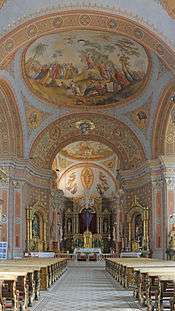1796 in architecture
The year 1796 in architecture involved some significant events.
| |||
|---|---|---|---|
|
Buildings and structures
|
Events
- October 8 – The Sans Souci Theatre in Westminster, London, opens to the public, built by dramatist, musician and painter Charles Dibdin.
Buildings and structures
Buildings
- Somerset House in London, designed by William Chambers is completed.
- The parish church of Urtijëi in the Italian Tyrol, designed by Joseph Abenthung, is completed.
- Hwaseong Fortress in Suwon, Korea, designed by Jeong Yak-yong, is completed.
- Work begins on Blaise Castle, commissioned by John Scandrett Harford from William Paty.
- Ffynone Mansion near Boncath in Wales, designed by John Nash, is largely completed.
- The Mosque of Amr ibn al-As in Fustat, Egypt, is rebuilt by Mamluk leader Mourad Bey.
Births
- date unknown – Mortimer Lewis, Colonial Architect of New South Wales (died 1879)
Deaths
- January 11 – Jacob Otten Husly, Dutch neoclassical architect (born 1738)
- March 1 – Carl Fredrik Adelcrantz, Swedish architect and civil servant (born 1716)
- March 10 – William Chambers, English architect and Surveyor-General and Comptroller of the King's Works (born 1723)
| Wikimedia Commons has media related to 1796 in construction. |
gollark: I can have baidicoot come up with a more recursive one eventually.
gollark: You just don't understand my genius.
gollark: It is a proof, it says so. This is irrelevant to the main question - what do we do about Tux1's alteriosity?
gollark: Or is it altitude?
gollark: Anyway, this should demonstrate Tux1's alternatecy excellently.
This article is issued from Wikipedia. The text is licensed under Creative Commons - Attribution - Sharealike. Additional terms may apply for the media files.
